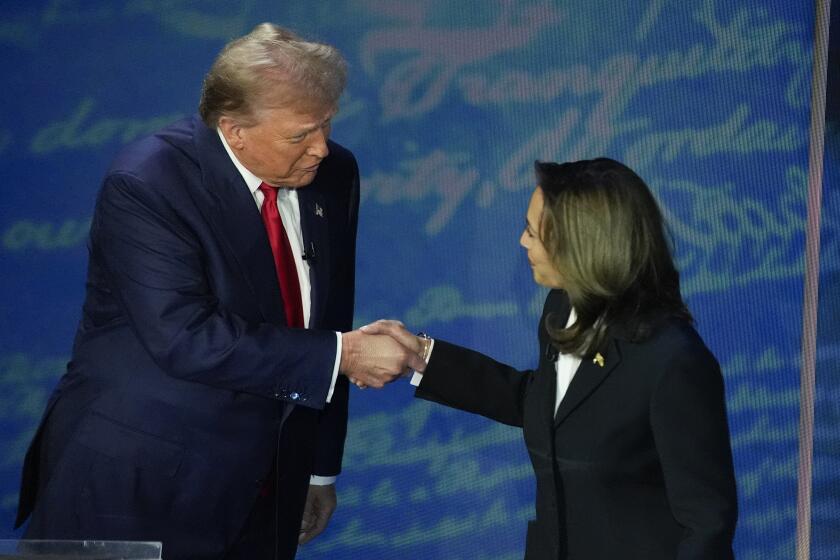On Prison Reform, Governor Breaks Free of Gridlock
Sen. Gloria Romero has been called a “hug-a-thug” because she crusades for prison reform. Actually, a thug on parole once kidnapped and threatened to kill her.
Romero (D-Los Angeles) had just exited a McDonald’s drive-through in Highland Park after ordering a cheeseburger Happy Meal, she vividly recalls. “An arm came in and I felt a piece of metal at my temple. It was a gun. I remember his saying, ‘Give me all your money or I’ll blow your head off.’ ”
She had only $12. The guy jumped in the car and ordered her to drive. Her 9-year-old daughter was in the back seat.
“He’s saying, ‘What else do you have?’ and he’s choking me. I’m saying, ‘Please don’t hurt us.’ Everything’s going down like in slow motion. I had to negotiate.”
She talked herself free. The thug took the car, crashed it, ran into a woman’s house and held her hostage ... before going back to prison for 12 years.
That was in 1995.
“If you can negotiate in that situation,” Romero says, “you can negotiate with Arnold.”
Indeed, the senator and Gov. Arnold Schwarzenegger recently negotiated the first significant compromise of the year between the governor and Legislature. It’s a shining -- if currently uncommon -- example of the governor and Legislature cooperatively progressing toward a common goal: in this case, prison reform.
They haven’t yet reached “reform.” But they’ve taken a major step, with reorganization of the state’s scandal-ridden, $7-billion prison system.
“Many question whether it’s even a system,” Romero noted at a news conference with Schwarzenegger two weeks ago. “It often seems [like] an uncoordinated network of 32 individual prisons with 32 individual chiefs of their own chiefdoms.”
Over the past year, California’s prisons have been rocked by federal investigations, budget overruns, a videotaped beating of juvenile inmates, a federal judge’s threat to place adult lockups in receivership and a rogue guards’ “code of silence.”
Under the reorganization, more power will shift to the secretary of the renamed Department of Corrections and Rehabilitation. This will give the secretary -- and his boss, the governor -- more flexibility to crack down and “reform.”
The word “rehabilitation” will be added to the department name as part of an increased emphasis on preparing inmates for life outside prison: counseling, schooling, job training. The recidivism rate for freed felons in California, 60%, is the highest in the nation.
There are many other details of the reorganization that are eye-glazing. But the main purpose is to move the ball forward on reform. The next steps, Schwarzenegger promises, are better rehabilitation, healthcare and juvenile programs.
The tentative plan is to sign the legislation this week at Folsom Prison.
It’s all that’s left of Schwarzenegger’s bold promise in his first State of the State speech to “blow up the boxes” of bureaucracy. This is a shuffling of boxes in just one agency.
Schwarzenegger’s original plan to abolish 88 boards and commissions was widely opposed and panned. In February, he abandoned the idea.
But he pushed ahead on prison reorganization. “Its need is the most urgent,” the governor asserted in his second State of the State speech. “There has been too much political influence, too much union control and too little management courage and accountability....
“I want to put the corrupt people in our prisons on the same side of the bars.”
That was another shot at the 32,000-member, politically potent prison guards union, the California Correctional Peace Officers Assn. Schwarzenegger from Day One has used the CCPOA as political fodder, denouncing it as a special interest. It definitely is, but the governor’s tone angered guards.
Most recently, the union and a victims’ group have been at war with the governor over his imposition of a liberal parole policy. He scrapped it last month, admitting the leniency didn’t work.
Meanwhile, Schwarzenegger also was brawling with teachers, nurses, firefighters and cop unions. It was in this hostile Capitol atmosphere that the governor sent the Legislature his prison reorganization plan for an up-or-down vote. Lawmakers could reject but not change it.
Given the sour mood, this would have been easy for Democrats to trash, handing Schwarzenegger an embarrassing defeat.
But Romero had spent years on prison reform. In fact, as a psychology student at UC Riverside, she had worked with Latino inmates at Chino prison, encouraging them to turn their lives around. This was a past the lawmaker shared with Schwarzenegger, she learned.
“When he was a bodybuilder, he used to go to prisons and give motivational speeches to inmates,” Romero says. “I’ve heard him say things like, ‘They’re not animals. They’re people, people make mistakes. Everybody deserves a second chance.’
“He’s the ‘Terminator.’ He never has to be worried about being called soft on crime.... He’s sensitive to victims and criminals.”
Romero, who heads a Senate prisons oversight committee, wanted to seize the opportunity. She and Schwarzenegger agreed that the Legislature would approve his reorganization but also pass a compromise bill that would immediately supersede it. The governor would save face. The Legislature would avoid looking obstructionist. Both would accomplish something.
“It’s an important lesson for the governor and also for the Legislature,” Romero says. “It’s government at work. I actually see a ray of sunshine....
“We actually smoked cigars in the tent. Arnold was Arnold. He is capable of bringing people together.”
If Schwarzenegger now could bring legislators together on other issues -- like spending and redistricting -- he could forget about a special election and save taxpayers $70 million.
More to Read
Get the L.A. Times Politics newsletter
Deeply reported insights into legislation, politics and policy from Sacramento, Washington and beyond. In your inbox three times per week.
You may occasionally receive promotional content from the Los Angeles Times.











